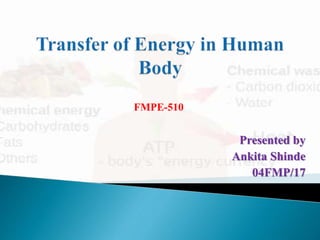Transfer of energy in human body
•Descargar como PPTX, PDF•
2 recomendaciones•1,962 vistas
Ankita Vilas Shinde Ph.D. Scholar
Denunciar
Compartir
Denunciar
Compartir

Recomendados
Recomendados
Más contenido relacionado
La actualidad más candente
La actualidad más candente (20)
physiotherapy Management in obesity,osteoporosis,diabetes,rickets

physiotherapy Management in obesity,osteoporosis,diabetes,rickets
Similar a Transfer of energy in human body
Similar a Transfer of energy in human body (20)
Energy systems in human body by arianaacardiorespiratory

Energy systems in human body by arianaacardiorespiratory
Último
Our CPM guide includes everything you need to get started in the Critical Path Method - with step-by-step examples, solutions, as well as schedules to help get your next project done faster and easier. The Critical Path Method (CPM) is a simple but powerful technique for analyzing, planning, and scheduling large, complex projects. It is used to determine a project’s critical path—the longest sequence of tasks that must be finished for the entire project to be complete.
CPM, also known as Critical Path Analysis (CPA), identifies dependencies between tasks, and shows which tasks are critical to a project. The Critical Path Method (CPM) is one of the most important concepts in project management, and certainly among the most enduring. But what is the Critical Path Method, exactly? This beginner-friendly guide will help you understand the Critical Path Method and apply it in your projects.
Early iterations of the Critical Path Method can be traced all the way back to the Manhattan Project in the early 1940s. Given the ambition, scale, and importance of this world-altering project, scientists - and the managers behind them - developed a number of techniques to make sure that the project delivered results on time. For a project management technique, the Critical Path Method has quite an illustrious history. One of these techniques was to map out the most important tasks in any project and use that to estimate the project completion date.
The Critical Path Method in project management is a cornerstone of project planning even to this day. How long a project takes often depends on the most important tasks that constitute it.Activity Planning: Objectives, Project Schedule, Network Planning Model. Time...

Activity Planning: Objectives, Project Schedule, Network Planning Model. Time...Lovely Professional University
Último (20)
Attraction and Repulsion type Moving Iron Instruments.pptx

Attraction and Repulsion type Moving Iron Instruments.pptx
An improvement in the safety of big data using blockchain technology

An improvement in the safety of big data using blockchain technology
RESORT MANAGEMENT AND RESERVATION SYSTEM PROJECT REPORT.pdf

RESORT MANAGEMENT AND RESERVATION SYSTEM PROJECT REPORT.pdf
Lect_Z_Transform_Main_digital_image_processing.pptx

Lect_Z_Transform_Main_digital_image_processing.pptx
Electrostatic field in a coaxial transmission line

Electrostatic field in a coaxial transmission line
Lecture_8-Digital implementation of analog controller design.pdf

Lecture_8-Digital implementation of analog controller design.pdf
Activity Planning: Objectives, Project Schedule, Network Planning Model. Time...

Activity Planning: Objectives, Project Schedule, Network Planning Model. Time...
Research Methodolgy & Intellectual Property Rights Series 2

Research Methodolgy & Intellectual Property Rights Series 2
Low rpm Generator for efficient energy harnessing from a two stage wind turbine

Low rpm Generator for efficient energy harnessing from a two stage wind turbine
Research Methodolgy & Intellectual Property Rights Series 1

Research Methodolgy & Intellectual Property Rights Series 1
Transfer of energy in human body
- 2. It is defined as the Ability or Capacity to do Work. All activities of the body, including thinking, involve energy consumption. When resting body’s energy consumption- • Skeletal Muscles & the Heart – 25% • The Brain – 19% • The Kidneys -10% • Liver % spleen _27% • Others -19%
- 6. Energy is produced in the presence of sufficient Oxygen. Aerobic systems produces large amounts of ATP without fatiguing by products hence it is the system used for long distance/endurance events.
- 7. Produce energy without depending on Oxygen Without oxygen = Activities that requires a large burst of energy over a short period of time. Anaerobic Glycolysis= Production of ATP from Carbohydrates without oxygen (breakdown of glucose)
- 8. ATP – Adenosine Triphosphate ATP= a form of energy one can immediately use, it is needed for cells to function & muscles to contract. Adenosine triphosphate is the basic energy currency for all biological work- When it is broken down, energy is released.
- 9. Only small amounts ATP is stored= only 2-3 sec. of Energy, therefore the rest is stored as: Glucose = Glycogen ( muscle & liver) Fatty Acids = Body fat Amino Acids = Growth, repair or excreted as waste. For longer periods of work = The Aerobic & Anaerobic Energy System be utilised.
- 10. ATP is stored in the muscle & liver for “Quick Energy”. Nerve impulses trigger breakdown of ATP into ADP. ADP= Adenosine Diphosphate & 1 Phosphate. The splitting of the Phosphate bond= Energy for work. Ex. Muscle Contraction, Moving hand from a hot stove, jumping & Throwing
- 12. Lactic acid present in the muscle decreases muscle pH, which in turn decreases the amount on glycolytic enzymes & the rate of ATP resynthesis, causing FATIGUE! Glycolytic enzymes are responsible for breaking down glycogen.
- 13. Food is the basic source of energy(fuel) for the body. The processes involved in the energy intake, storage, & use by the body are collectively called the Metabolism.
- 15. Energy used for basal metabolism becomes heat. This heat is mainly dissipated through the skin. Thus, BMR is approximately proportional to the surface area of the animal. When body has used the energy from all of the consumed food , it then starts using up your energy stores.